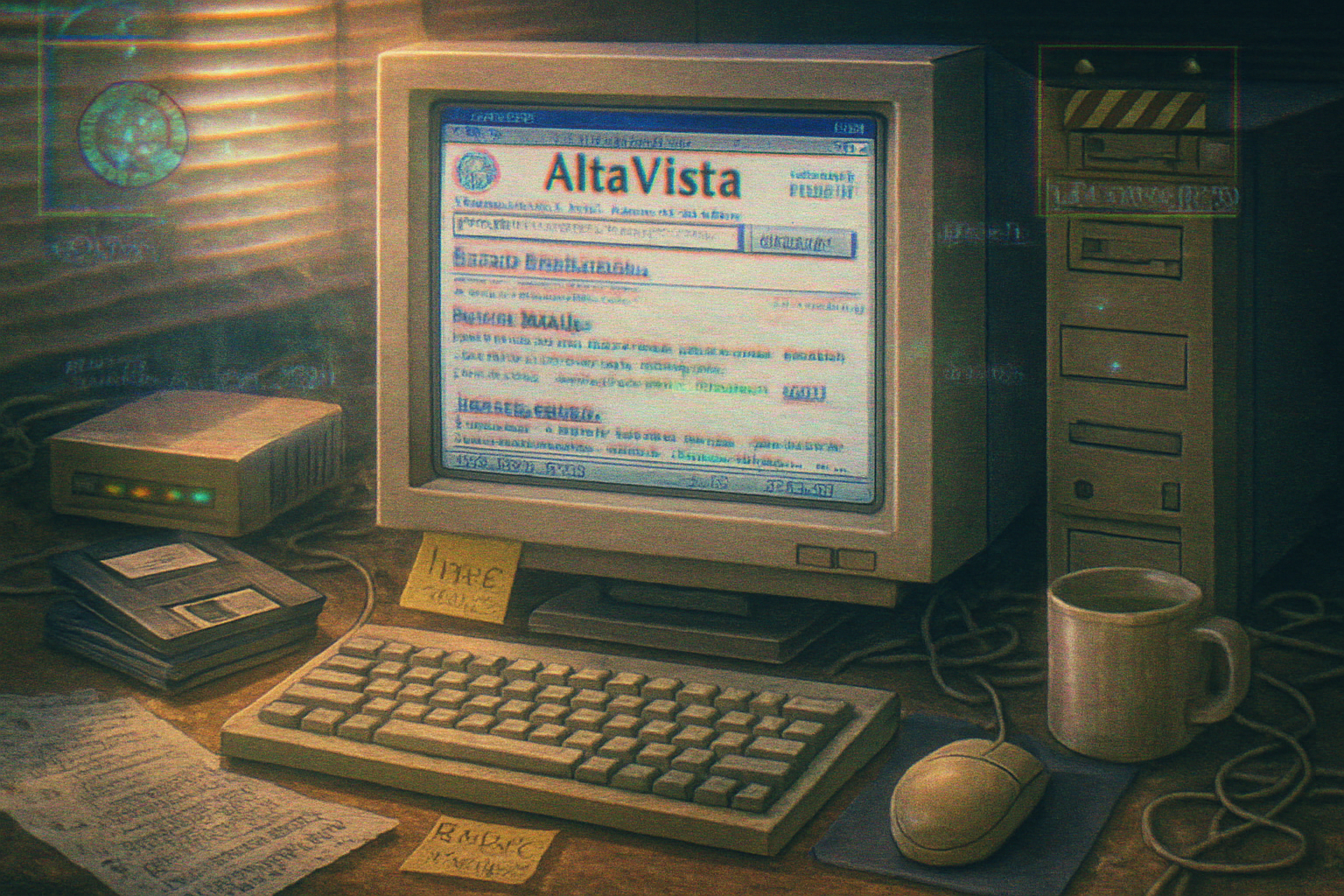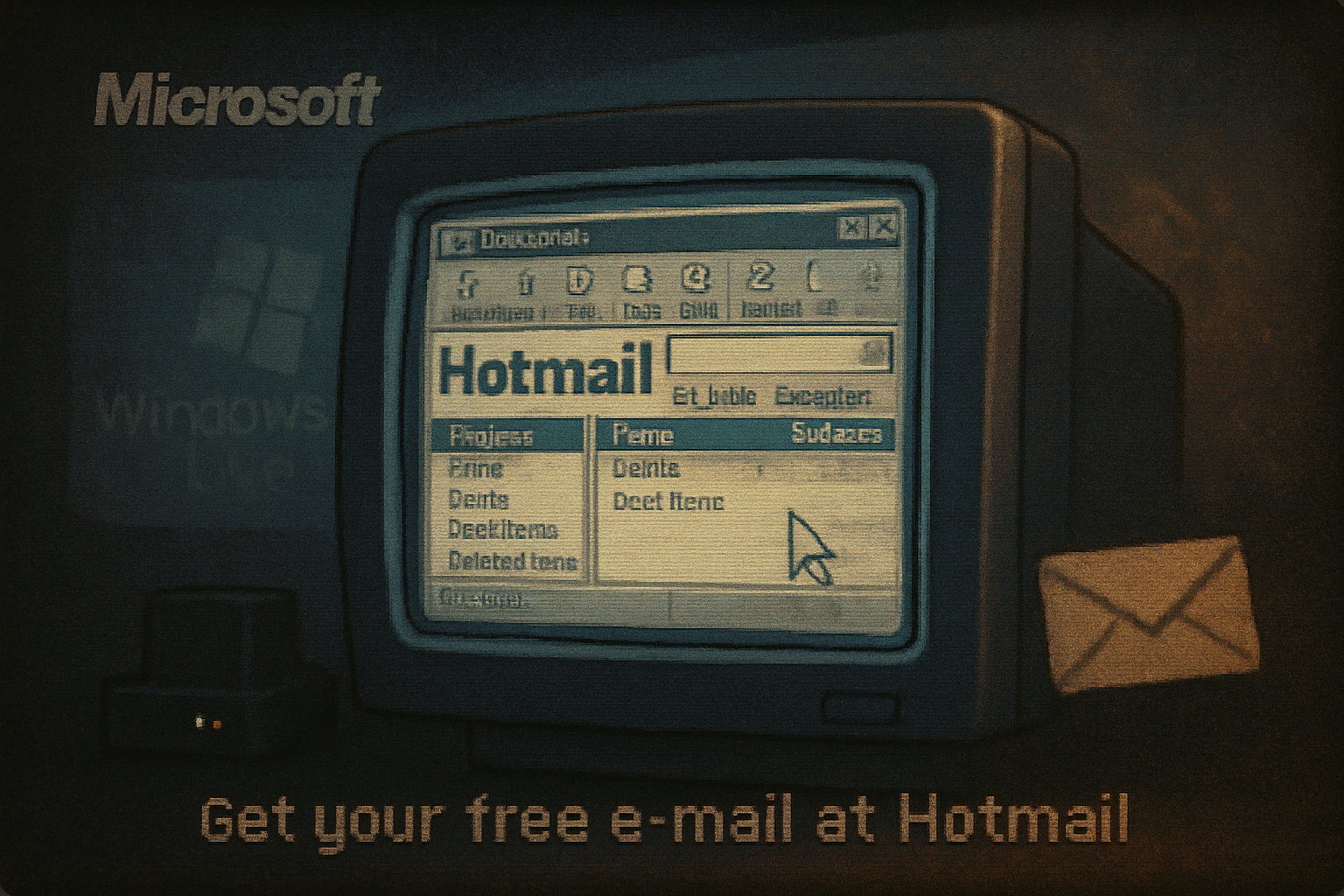· retrotech · 6 min read
AltaVista’s Forgotten Legacy: How a Search Engine Became a Digital Time Capsule
A look back at AltaVista - the 1990s search engine that accelerated web search, introduced features we take for granted today, and unintentionally preserved early web history like a digital time capsule.

The search engine that once defined the web
In 1995, when most people still connected to the internet over dial-up and websites were a patchwork of hand-coded HTML pages, a search engine arrived that felt shockingly fast and comprehensive. AltaVista didn’t just find words on pages - it changed expectations about speed, comprehensiveness, and what a search interface could do. For a time it was the go-to gateway to the web, and in the process it became an unintended archive of the early internet.
This article revisits AltaVista’s innovations, the features that shaped modern search, and how its ephemeral presence now reads like a digital time capsule.
Where AltaVista fit in the 1990s internet
AltaVista was created by engineers at Digital Equipment Corporation’s research labs and launched in late 1995. At a moment when many sites were small and decentralized, AltaVista brought industrial-scale crawling and indexing to the public web. Its value wasn’t just that it returned results - it returned them quickly and at scale.
Early search tools either scanned only limited sets of pages or provided primitive matching. AltaVista’s engineering-first approach made it possible to index millions of pages and serve queries with a responsiveness that felt new. That raw performance changed user expectations and pushed the whole web toward index-driven discovery.
(For an overview of AltaVista’s history and features, see the AltaVista entry on Wikipedia.)[https://en.wikipedia.org/wiki/AltaVista]
What AltaVista introduced (and what survived)
AltaVista did several things that are now commonplace, and a few that feel like striking relics of the 90s:
Fast, large-scale crawling and indexing. AltaVista invested in aggressive crawling and a powerful index for its time. That approach - continuously crawling and indexing broad swathes of the web - is the foundation of every modern search engine.
Rich query syntax and advanced search forms. AltaVista offered boolean operators, fielded searches and more advanced query options than many contemporaries. These controls anticipated the advanced search UIs power users still reach for today.
Cached snapshots of pages. AltaVista kept copies of pages it crawled and allowed users to view caches - a capability that later became central to web preservation and to debugging broken sites.
Early multimedia and translation experiments. AltaVista exposed users to image search and, famously, the Babelfish translation service (early machine translation offered via its site), which lowered barriers for cross-language discovery and hinted at the multilingual web to come ([Babelfish - Wikipedia]).[https://en.wikipedia.org/wiki/Babelfish_(web_service)]
A bridge between research and consumer product. Built from a research lab’s software stack and deployed on high-performance hardware, AltaVista showed how cutting‑edge lab work could become a consumer-facing service.
Many of these ideas - continuous crawling, cached results, richer query handling, cross-language tools - are pillars of modern search platforms.
The user experience and cultural imprint
Using AltaVista in the 90s had sensory specificity: a cramped homepage full of links and options, a feeling of exploration, and the thrill of results arriving quickly over a noisy dial-up connection. For journalists, students and developers it became an indispensable tool. AltaVista’s prominence made it part of internet culture: a shorthand for the ability to find something on the web.
Because AltaVista indexed extensive portions of the early web, its results - and the cached copies it served - captured ephemeral pages, personal homepages, early forums and early multimedia files. Those snapshots are now cultural artifacts. Even when AltaVista itself faded, its footprints lived on through archived copies and the research papers inspired by it.
You can still trace AltaVista’s public pages through the Wayback Machine and other archives, which highlights the service’s role in preserving early web states.[https://web.archive.org/web/*/altavista.com]
Where things went wrong (and why it faded)
AltaVista’s decline is a well-studied example of how technical leadership doesn’t guarantee lasting dominance. A few contributing factors were:
Commercial pressure and product bloat. As the web commercialization wave intensified, AltaVista experimented with portal-style content, advertising and added services. That shifted the product away from the fast, focused search experience many users preferred.
Changing ranking paradigms. Early AltaVista relevance depended heavily on text matching and heuristics. When link-focused ranking ideas (like Google’s PageRank) proved superior at surfacing authoritative pages, AltaVista’s relevance model struggled to compete.
Ownership and strategy churn. AltaVista changed hands several times and was folded into different corporate strategies that didn’t always prioritize search innovation. Eventually it was absorbed into larger portal/advertising ecosystems and lost its distinct engineering-first identity.
By the early 2000s a new generation of search engines had refined relevance models, monetization strategies, and product simplicity. AltaVista’s prominence dwindled, and although its name persisted for years as a brand, the service was ultimately retired in the 2010s.
AltaVista as a digital time capsule
Two aspects of AltaVista make it feel like a time capsule:
Its indexes captured a huge swath of the pre-2000 web. Many early pages that no longer exist today were indexed and sometimes cached by AltaVista. Those records are pieces of internet history - snapshots of how people and organizations presented themselves online.
Its feature set reflected the ambitions and anxieties of the period - search as a toolbox, experiment-driven features like Babelfish, and an interface thick with controls. That contrasts with today’s minimal search boxes and algorithmic ranking decisions.
Because AltaVista cataloged so much of the web during a formative period, researchers and historians sometimes use references to it and its cached content to reconstruct how the web looked and behaved in the 1990s.
Lessons AltaVista left behind
AltaVista’s arc offers practical lessons for technologists and product leaders:
Performance and scale matter, but so does relevance. A fast index gets you noticed; a relevance model that surfaces authoritative answers keeps users engaged.
Simplicity can outlast feature bloat. As search matured, users favored clearer, faster experiences over portals packed with unrelated services.
Research-to-product pathways are powerful - but they must be paired with a sustainable product strategy. Bringing lab-grade innovations to users is valuable, but long-term success also requires coherent business and product discipline.
Preservation happens as a byproduct of scale. Systems built for practical reasons (like caching for performance) can become invaluable archives for future historians.
Why AltaVista still matters today
AltaVista didn’t become the long-term winner in web search, but its influence is visible everywhere: large-scale crawling and indexing, cached pages, advanced query options and early experiments in machine translation all helped define what a modern search engine can be. Beyond technical contributions, AltaVista captured slices of internet life that would otherwise be harder to recover.
In that sense, AltaVista’s forgotten legacy is twofold: tangible engineering contributions that shaped later search engines, and a set of preserved artifacts - the indexed and cached pages - that let us peer into the early web.
Remembering the noise of dial-up
If you remember loading AltaVista on a CRT monitor and watching results populate line-by-line, that feeling is part nostalgia and part technological history. AltaVista was more than a product; it was a moment when the web felt new, searchable and suddenly discoverable. The service may be gone, but its fingerprints remain in how we find information online - and in the archived pages that serve as a digital time capsule of the web’s teenage years.
References and further reading
- AltaVista - Wikipedia: https://en.wikipedia.org/wiki/AltaVista
- Babelfish (web service) - Wikipedia: https://en.wikipedia.org/wiki/Babelfish_(web_service)
- AltaVista snapshots on the Wayback Machine: https://web.archive.org/web/*/altavista.com



